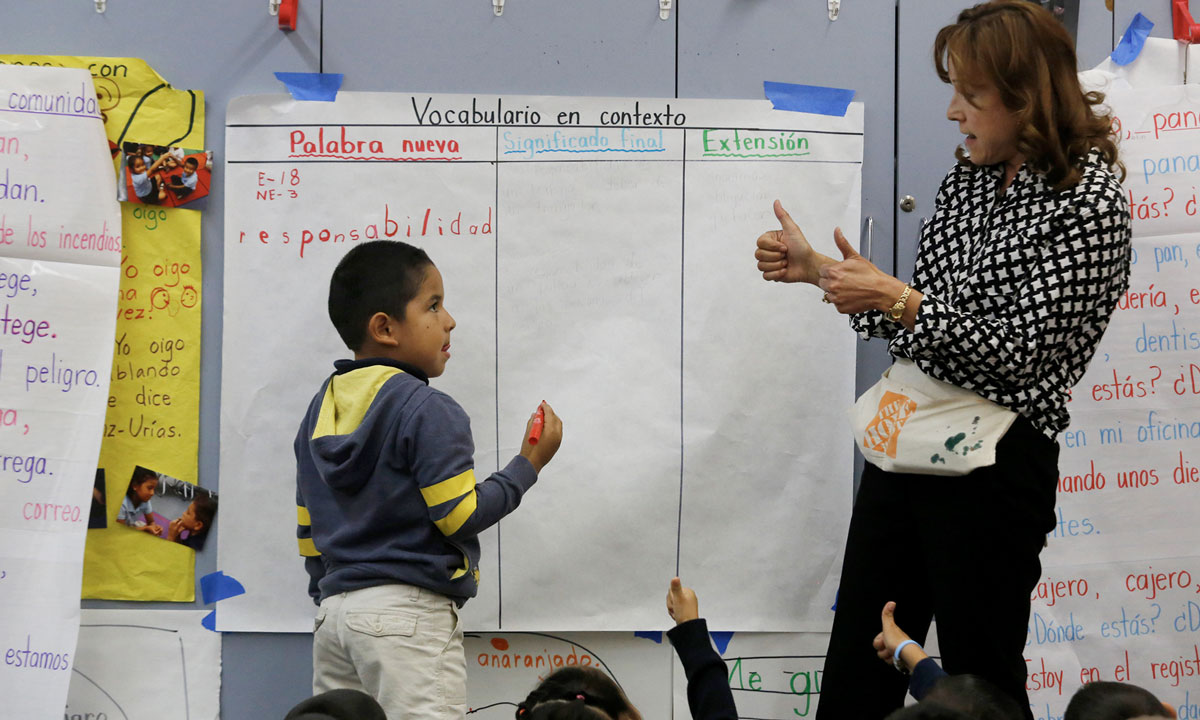California Celebrates Its Linguistic Diversity While Shortchanging Bilingual Ed
Calif. has 1.1M English learners and a $130B state education budget, but less-diverse states with fewer resources are making more robust investments.

Get stories like this delivered straight to your inbox. Sign up for The 74 Newsletter
California always seems to be ahead of the curve. Huge numbers of you are reading this column on Apple devices designed in Cupertino — and you got here by clicking a link on one of the social media companies with headquarters just down the road from there in Silicon Valley.
The Golden State: it’s where America looks for progress.
But leading the curve isn’t an unalloyed good. Various booms powered by its tech sector have brought California a dynamic labor market and simultaneously made it a national leader in economic inequality. California is pioneering aggressive policies for slowing the pace of climate change even as escalating wildfires and water use uncertainties leave it ahead of most states in facing climate change’s consequences.
Perhaps most of all, California is the American vanguard when it comes to demographics. America’s future is moving towards racial, ethnic and linguistic diversity—versions of those trends have already arrived in California’s present. As my co-author Jonathan Zabala and I put it in our recent Century Foundation report, Moving from Vision to Reality: Establishing California as a National Bilingual Education and Dual-Language Immersion Leader:
In 2021–22, the state’s schools were 56 percent Latino/a/x, 10 percent Asian, 5 percent African-American, 4 percent multiracial, and 2 percent Filipino. Just 21 percent of California students identify as white. In 2022, roughly 40 percent of California K–12 students spoke a non-English language at home. California schools enroll nearly 1.1 million students who are classified as English learners (ELs)—meaning that the state’s ELs constitute more than 21 percent of the U.S.’ 5 million ELs.
California leans global: its leaders never tire of comparing the state’s economic output to other countries’. But when it comes to its genuinely international-grade linguistic diversity, California has long been ambivalent. In 1998, the state’s voters passed Proposition 227, mandating monolingual, English-only instruction across its schools. It took nearly two decades — and piles of research showing that this approach is ineffective — before the state reversed course in a 2016 referendum and embraced the value of its burgeoning multilingualism in California classrooms.
Our report charts California’s progress in the seven years since then. The state has done much to align its vision for ELs’ success with research on these children’s linguistic and academic development—in particular, by prioritizing access to bilingual instruction. After the 2016 referendum, state leaders launched initiatives setting ambitious goals for improving ELs’ educational opportunities in the state’s schools—the English Learners Roadmap and Global California 2030. In the latter, for instance, the state pledged to “quadrupl[e] the number of [dual-language immersion] programs from 407 in 2017 to 1,600 in 2030,” and have “three out of four students [be] proficient in two or more languages, earning them a State Seal of Biliteracy.”
State legislators have backed these — and related — objectives with some modest resources, including $10 million in state grants to launch 55 new dual-language programs in coming years. It has also provided funding for several programs aimed at increasing the diversity of California teachers and/or filling teacher shortages that include efforts to grow the state’s bilingual teacher corps.
And yet, much remains to be done. That $10 million in grants reached 27 local education agencies, leaving 991 without any funding incentive to convert their English-only programs to bilingual campuses. That’s nowhere near enough to reach the Global California goals. As of 2019–20, California enrolled roughly 1 in 6 of its more than 1 million ELs in some form of bilingual education or dual-language immersion—the models that research suggests are best for these students. This ranks California well behind its peers—both EL-rich states like Texas and Illinois and less linguistically diverse states like Wisconsin and Alaska.
As we note in the report, this is partly driven by a shortage of state funding for bilingual and dual-language programs. California’s single $10 million dual-language immersion grants competition is nowhere near large enough to keep pace with other states:
Utah—a state that enrolled just over 54,000 ELs in 2020 and has an annual K–12 education state budget of just over $8 billion—still committed more than $5 million to its dual-language immersion program in 2023, and has appropriated more than $7.3 million to the program for 2024. Since 2012, Delaware—a state with fewer than 15,000 ELs in 2020 and an annual K–12 education budget of not quite $2 billion—has annually spent between $1.6 million and $1.9 million on dual-language immersion expansion…California, by comparison, enrolled 1.1 million ELs in 2020 and has an annual K–12 [state education]budget of nearly $130 billion.
Forget international comparisons—when it comes to building a genuinely multilingual public education system suited to the 21st century’s global economy, California isn’t even atop the U.S.’s interstate leaderboard. The state simply has not yet made it a priority to invest proportional resources into programs that meaningfully extend ELs’ access to bilingual and/or dual language opportunities.
Indeed, support for ELs’ bilingualism has not been a priority even in other new statewide education reforms. As we outline in the report, though California has invested major new public resources in trying to achieve universal access to early education programs for 4-year-olds and growing the state’s roster of community schools — ELs’ unique strengths and needs have not been central to these initiatives’ designs.
This is equal parts frustrating and surprising for a state with California’s political climate and demographic advantages. An overwhelmingly progressive state that publicly proclaims the value of its students’ remarkable linguistic, cultural and ethnic diversity cannot celebrate these very modest bilingualism investments as sufficient.
Get stories like these delivered straight to your inbox. Sign up for The 74 Newsletter

;)
